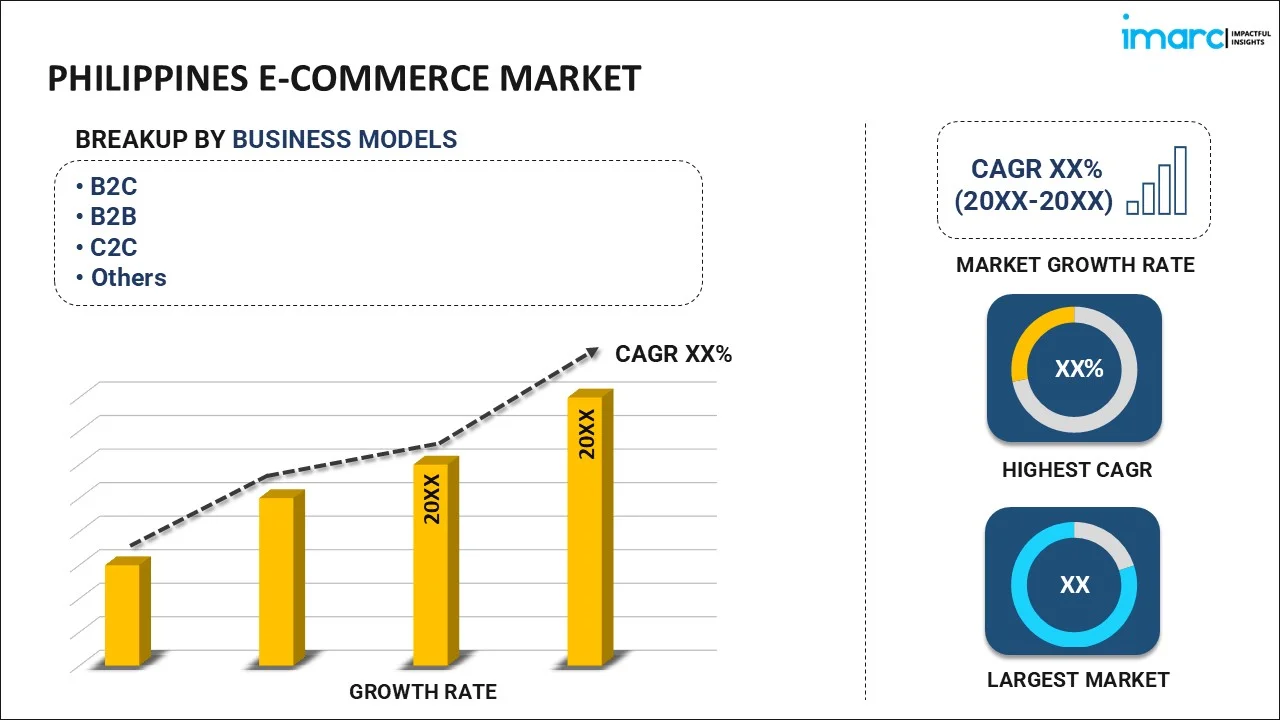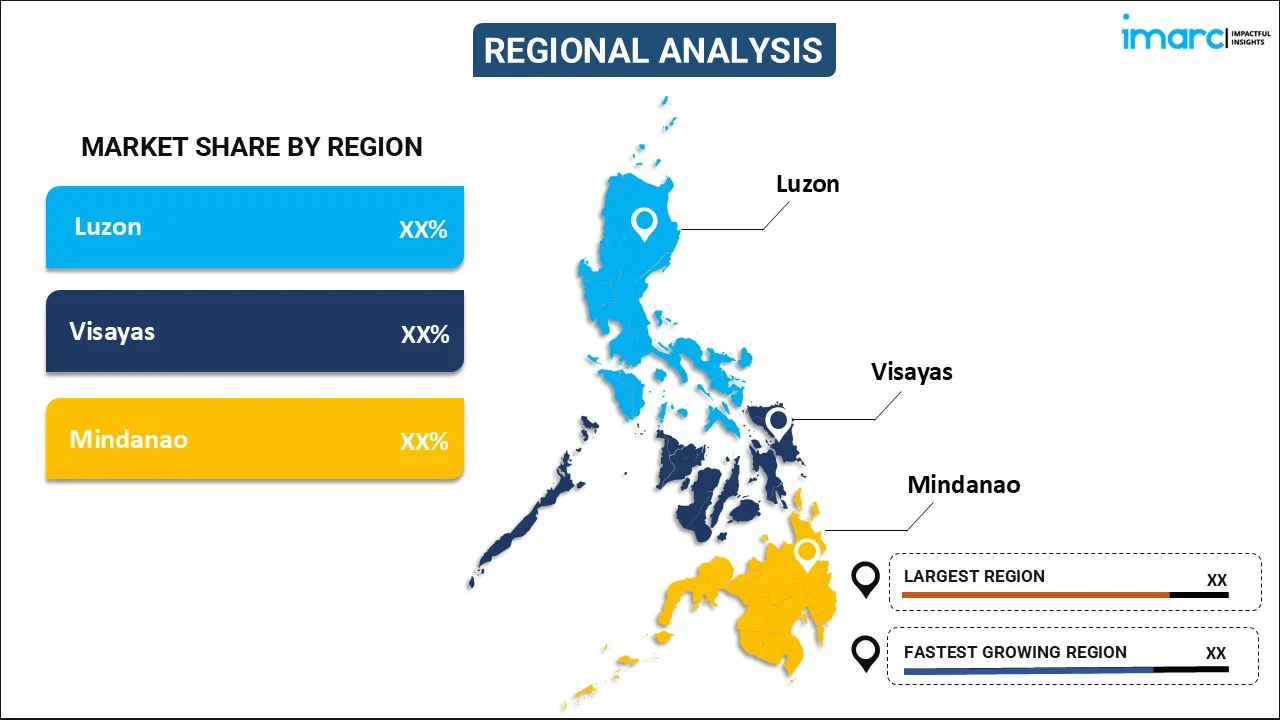
Philippines E-commerce Market Size, Share, Trends and Forecast by Business Model, Mode of Payment, Service Type, Product Type, and Region, 2025-2033
Philippines E-commerce Market Overview:
The Philippines e-commerce market size reached USD 24.53 Billion in 2024. Looking forward, IMARC Group expects the market to reach USD 75.59 Billion by 2033, exhibiting a growth rate (CAGR) of 14.02% during 2025-2033. The Philippines e-commerce market share is expanding, driven by the growing investments in user-friendly websites and targeted online marketing to engage with users effectively, along with innovative features like encryption, two-factor authentication, and biometric verification in digital payment services, which lower the risk of fraud and theft.
|
Report Attribute
|
Key Statistics
|
|---|---|
|
Base Year
|
2024 |
|
Forecast Years
|
2025-2033
|
|
Historical Years
|
2019-2024
|
| Market Size in 2024 | USD 24.53 Billion |
| Market Forecast in 2033 | USD 75.59 Billion |
| Market Growth Rate (2025-2033) | 14.02% |
Philippines E-commerce Market Trends:
Expansion of Retail Channels
The rising reliance on e-commerce platforms by established retail brands is impelling the Philippines e-commerce market growth. It is enabling the seamless integration of offline and online channels to extend their reach to a wider audience. Retailers are capitalizing on the changing shopping marketspace and buyer preferences, with digital commerce gaining traction among Filipinos. Online shopping is highly adaptive, as it reduces time spent while commuting and waiting in queues. Online retail provides shoppers the convenience to browse and purchase products from the comfort of their homes, without the hassle of visiting physical stores. Buyers have easy access to a vast selection of products, often beyond what is available in local stores. They can compare item features, prices, and reviews across multiple sellers to make informed and suitable decisions. Moreover, online platforms frequently offer discounts, deals, and price comparisons, helping customers make cost-effective choices. With the help of advanced algorithms, businesses provide customized suggestions according to browsing and buying habits, enhancing the shopping experience. People can purchase products from international retailers, gaining access to unique items, without any geographical restraints. Traditional retailers, influenced by the high demand for digital solutions, are investing in user-friendly websites and targeted online marketing to engage with users more effectively. As per the IMARC Group’s report, the Philippines retail sector market is expected to reach USD 133.2 Billion by 2032.
Rising Digital Payment Adoption
In 2024, the World Bank Board of Directors approved a USD 750 Million second digital transformation development policy loan in Philippines to improve trust in e-commerce and build advanced payments infrastructure. As more people are using internet-connected smartphones, there is a rise in the adoption of online payment services. Digital payments enable quick and easy transactions anytime and anywhere, reducing dependency on physical cash or checks. Businesses can cater to wider audiences by accepting various digital payment methods. Payments can be completed in seconds, which minimizes delays in both online and in-person purchases. Digital payment services streamline payment processes and aid in reducing administrative tasks and transaction errors. Additionally, innovative features like encryption, two-factor authentication, and biometric verification reduce the risk of fraud and theft and ensure security. Digital payments automatically generate transaction histories, which help users to track expenses and manage finances. Furthermore, government initiatives promoting a cashless economy are offering a favorable Philippines e-commerce market outlook.
Philippines E-commerce Market Segmentation:
IMARC Group provides an analysis of the key trends in each segment of the market, along with forecasts at the country level for 2025-2033. Our report has categorized the market based on business model, mode of payment, service type, and product type.
Business Model Insights:

- B2C
- B2B
- C2C
- Others
The report has provided a detailed breakup and analysis of the market based on the business models. This includes B2C, B2B, C2C, and others.
Mode of Payment Insights:
- Payment Cards
- Online Banking
- E-Wallets
- Cash-On-Delivery
- Others
A detailed breakup and analysis of the market based on the modes of payments have also been provided in the report. This includes payment cards, online banking, e-wallets, cash-on-delivery, and others.
Service Type Insights:
- Financial
- Digital Content
- Travel and Leisure
- E-Tailing
- Others
The report has provided a detailed breakup and analysis of the market based on the service types. This includes financial, digital content, travel and leisure, e-tailing, and others.
Product Type Insights:
- Groceries
- Clothing and Accessories
- Mobiles and Electronics
- Health and Personal Care
- Others
A detailed breakup and analysis of the market based on the product types have also been provided in the report. This includes groceries, clothing and accessories, mobiles and electronics, health and personal care, and others.
Regional Insights:

- Luzon
- Visayas
- Mindanao
The report has also provided a comprehensive analysis of all the major regional markets, which include Luzon, Visayas, and Mindanao.
Competitive Landscape:
The market research report has also provided a comprehensive analysis of the competitive landscape. Competitive analysis such as market structure, key player positioning, top winning strategies, competitive dashboard, and company evaluation quadrant has been covered in the report. Also, detailed profiles of all major companies have been provided.
Philippines E-Commerce Market News:
- In March 2024, HSBC Philippines introduced ‘Omni Collect’, an advanced payment solution with in-built application programming interface (API) designed for e-commerce businesses. It ensures seamless transactions across online, offline, and mobile platforms and enables businesses to accept payments from various sources through a centralized interface.
- In July 2024, FedEx teamed up with eBay, a top-rated e-commerce business to extend their marketspaces. This alliance was set to roll out in Philippines and other countries of the Asia-Pacific region to enhance the online shopping and delivery experience of customers.
Philippines E-commerce Market Report Coverage:
| Report Features | Details |
|---|---|
| Base Year of the Analysis | 2024 |
| Historical Period | 2019-2024 |
| Forecast Period | 2025-2033 |
| Units | Billion USD |
| Scope of the Report | Exploration of Historical Trends and Market Outlook, Industry Catalysts and Challenges, Segment-Wise Historical and Future Market Assessment:
|
| Business Models Covered | B2C, B2B, C2C, Others |
| Modes of Payments Covered | Payment Cards, Online Banking, E-Wallets, Cash-On-Delivery, Others |
| Service Types Covered | Financial, Digital Content, Travel and Leisure, E-Tailing, Others |
| Product Types Covered | Groceries, Clothing and Accessories, Mobiles and Electronics, Health and Personal Care, Others |
| Regions Covered | Luzon, Visayas, Mindanao |
| Customization Scope | 10% Free Customization |
| Post-Sale Analyst Support | 10-12 Weeks |
| Delivery Format | PDF and Excel through Email (We can also provide the editable version of the report in PPT/Word format on special request) |
Key Questions Answered in This Report:
- How has the Philippines e-commerce market performed so far and how will it perform in the coming years?
- What is the breakup of the Philippines e-commerce market on the basis of business model?
- What is the breakup of the Philippines e-commerce market on the basis of mode of payment?
- What is the breakup of the Philippines e-commerce market on the basis of service type?
- What is the breakup of the Philippines e-commerce market on the basis of product type?
- What are the various stages in the value chain of the Philippines e-commerce market?
- What are the key driving factors and challenges in the Philippines e-commerce market?
- What is the structure of the Philippines e-commerce market and who are the key players?
- What is the degree of competition in the Philippines e-commerce market?
Key Benefits for Stakeholders:
- IMARC’s industry report offers a comprehensive quantitative analysis of various market segments, historical and current market trends, market forecasts, and dynamics of the Philippines e-commerce market from 2019-2033.
- The research report provides the latest information on the market drivers, challenges, and opportunities in the Philippines e-commerce market.
- Porter's five forces analysis assist stakeholders in assessing the impact of new entrants, competitive rivalry, supplier power, buyer power, and the threat of substitution. It helps stakeholders to analyze the level of competition within the Philippines e-commerce industry and its attractiveness.
- Competitive landscape allows stakeholders to understand their competitive environment and provides an insight into the current positions of key players in the market.
Need more help?
- Speak to our experienced analysts for insights on the current market scenarios.
- Include additional segments and countries to customize the report as per your requirement.
- Gain an unparalleled competitive advantage in your domain by understanding how to utilize the report and positively impacting your operations and revenue.
- For further assistance, please connect with our analysts.
 Inquire Before Buying
Inquire Before Buying
 Speak to an Analyst
Speak to an Analyst
 Request Brochure
Request Brochure
 Request Customization
Request Customization




.webp)




.webp)












